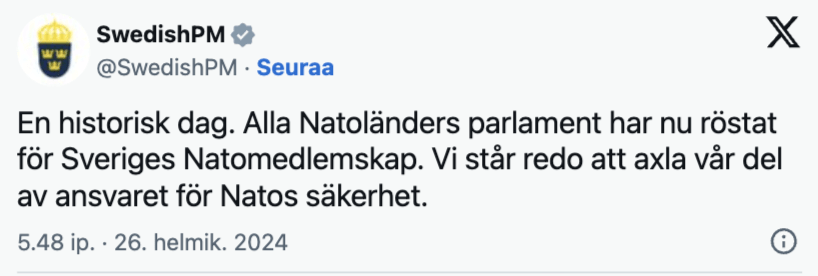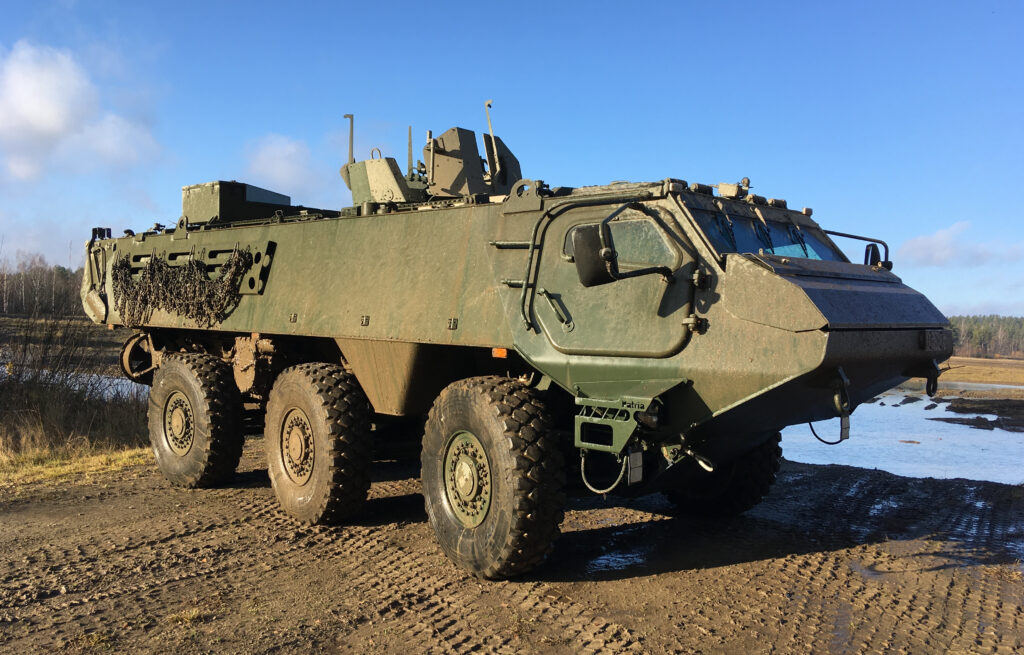Sweden is leaving behind 200 years as a non-aligned country after the Hungarian parliament approved Sweden’s NATO membership. Just days before, Hungary decided to buy four additional Saab Gripen C fighters.
“Sweden is leaving behind 200 years as a non-aligned country. It’s a big step that needs to be taken seriously, but it’s also a natural step,” the Swedish Prime Minister Ulf Kristersson said at the press conference after the Turkish parliament finally approved Sweden’s NATO membership by a vote of 188 to 6.
He pointed out that Sweden’s membership will give the Nordic countries a unified defence for the first time in 500 years.
“A historic day. The parliaments of all NATO countries have now voted in favour of Sweden’s NATO membership. We stand ready to take our share of responsibility for NATO’s security,” Prime Minister Kristersson wrote in his X update. Sweden had already signed a defence cooperation agreement (DCA) with the United States similar to Finland’s.
“We become the natural thread of life for the East. Towards Finland, towards the Baltics,” Micael Bydén, Commander of the Swedish Armed Forces, said in a recent interview with Dagens Nyheter, the Swedish daily. The country’s defence budget of SEK 119 billion for 2024 already corresponds to the required two percent of GDP according to NATO’s calculations.
Sweden has also already pledged to use its ground forces to help strengthen NATO’s eastern flank. It is sending its soldiers to a Canadian-led battlegroup in Latvia.

Nordic Airforce: 300 Fighters
Sweden is in the process of constructing two new submarines with a combined value exceeding one billion euros, with the initial vessel expected to be operational by 2027. Additionally, Sweden boasts a formidable air force. The region’s aerial combat capabilities will be significantly enhanced within the Nordic NATO member states when the fleets of Finland’s 64 F-35s and Sweden’s estimated 100 Jas Gripen planes are integrated, complementing the existing strength of Norwegian and Danish air forces.
By the turn of the decade, these three countries will have a total of 143 fifth-generation F-35 fighters at their disposal. In addition, Sweden has just under a hundred JAS 39 Gripen fighters and has ordered dozens more. The total number is therefore likely to be somewhat less than 300 fighters, half of which are the most advanced models possible. This compares to the fact that Germany’s Luftwaffe has 35 F-35 orders and Britain’s Royal Air Force 138. Russia has about 600 first-line fighter jets, but Ukraine is thinning that figure as best it can. In the West, the availability rate of machines is higher than in Russia.
Underwater Superpower
By joining NATO, Sweden will bolster the alliance’s defensive posture in northwest Europe, particularly in the strategic Baltic Sea corridor, which it shares with Russia and serves as a critical passage to ports across eight nations, including Denmark and Germany. Sweden’s strategic advantage in maintaining the Baltic Sea’s navigability during conflicts lies in its possession of a premier submarine fleet, regarded by experts as one of the most sophisticated in terms of conventional submarines.
The Baltic Sea sometimes referred to whimsically as a “flooded meadow” due to its average depth of approximately 60 meters, is not suited for the larger, nuclear-powered submarines that form the mainstay of Russia’s submarine force and the entirety of the United States Navy. Sweden operates a trio of advanced Gotland-class submarines, alongside an older submarine set to be decommissioned with the arrival of two state-of-the-art A26 vessels scheduled for delivery in 2027 and 2028. This expansion will bring Sweden’s total to five submarines by the decade’s end. Sweden’s history of submarine activity in the Baltic stretches back to 1904, with no neighboring nation matching its level of undersea engagement. The Swedish Gotland-class submarines were the first in the world to feature a Stirling engine air-independent propulsion (AIP) system, which extends their underwater endurance from a few days to weeks. This capability had previously only been available with nuclear-powered submarines.
This regional acumen is a unique asset to NATO, filling a niche of expertise previously absent within the alliance.
Investments and Gripens to Hungary
“Sweden in NATO will strengthen Hungary’s security”, Prime Minister Viktor Orbán said in his speech in parliament. Earlier, Hungary and Sweden had agreed on the purchase of an additional four Gripen C fighters and extended the support agreement for previously leased fighters for ten years This order follows an amendment to the contract between the Swedish Defence Materiel Administration (FMV) and the Hungarian Government signed in December 2001 regarding 14 Gripen C/D fighters for the Hungarian Air Force.
Saab and the Hungarian Ministry of Defence have also signed an MoU regarding the development of high-tech industrial areas and fighter aircraft capabilities. The cooperation includes support for the establishment of a Centre of Excellence for VR technologies in Hungary.
According to Micael Johansson, President and CEO of Saab, the company is rseady to provide additional upgrades and support for the Hungarian fighters beyond 2035.
The forthcoming aircraft are expected to adhere to the most up-to-date MS20 Block 2 configuration that is currently being integrated into the Hungarian Air Force’s (HuAF) existing Gripen fleet. This enhanced standard encompasses a suite of upgrades such as the augmented Saab PS-05/A Mk4 radar system, which offers extended air-to-air target tracking range and heightened overall operational performance. Additionally, the standard bolsters the Link 16 datalink functionalities and incorporates the cutting-edge NATO Mode 5 IFF (Identification Friend or Foe) system, as detailed in an analysis by Jane’s Defense.
Jane’s Defense notes that with the MS20 Block 2 upgrade, Hungary’s air force will have access to a broader arsenal of weaponry. This includes the Diehl IRIS-T and MBDA Meteor air-to-air missiles, the RTX AIM-130C-8 Advanced Medium-Range Air-to-Air Missiles (AMRAAMs), the Raytheon GBU-49 Paveway precision-guided bomb, and the refined DM113 FAP (frangible armour piercing) rounds for the aircraft’s 27 mm cannon.
Read More:
- Dagens Nyheter: ÖB om bristen på utrustning: ”Ett misslyckande” (in Swedish)
- SVT: Här är kostnaderna för Sveriges Natomedlemskap (in Swedish)
- Reuters: What Sweden’s submarines bring to NATO
- Helsingin Sanomat: Ruotsin pääministeri Kristersson: ”Suomi on ollut erittäin rakas ystävä” (in Finnish)
- Saab: Saab receives Gripen order for Hungary
- Jane’s Defense: Hungary increases Gripen fleet



